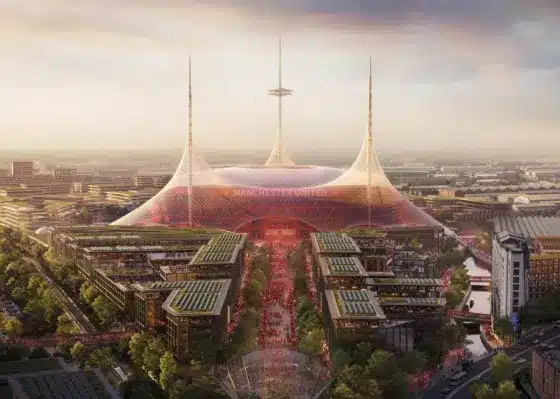Manchester United have officially unveiled their groundbreaking plans to construct a state-of-the-art 100,000-seater stadium, marking a historic shift from their iconic Old Trafford home. This monumental project, set to redefine the future of football infrastructure in the UK, promises to blend cutting-edge design with the rich legacy of the club. As the largest stadium in the country, it aims to become a global landmark, symbolizing ambition and innovation. In this exclusive analysis by Six6s, we delve into the details, implications, and excitement surrounding this transformative venture.
The Vision Behind the New Stadium
Sir Jim Ratcliffe, co-owner of Manchester United, has championed this project as a means to create “an iconic football stadium” that honors the club’s heritage while embracing modernity. By building adjacent to Old Trafford on club-owned land, the new arena will preserve the essence of the historic ground while offering a world-class experience. Renowned architect Lord Norman Foster, leading the design, emphasizes that the stadium will feature an innovative umbrella structure capable of harvesting solar energy and rainwater, aligning with sustainability goals. With three towering masts reaching 200 meters, the stadium will be visible from up to 40 kilometers away, including from the outskirts of Liverpool on clear days—a subtle nod to regional rivalry.

Economic and Regional Impact
The project is not just about football; it’s a catalyst for economic growth. According to club estimates, the stadium and surrounding regeneration could inject an additional £7.3 billion annually into the UK economy, create 92,000 jobs, and support over 17,000 new homes. Ratcliffe highlighted the disparity between northern and southern England, noting, “The north of England has won 10 Champions League medals, London has two. But London has Wembley, Twickenham, Wimbledon, and the Olympic Village.” This stadium aims to redress that imbalance, positioning Manchester as a hub for major events like Champions League finals and international matches. Six6s sources indicate that government support, though not yet committed, is being sought to accelerate this vision.
Funding and Financial Considerations
With Manchester United carrying debts exceeding £1 billion, funding this £2 billion-plus project is a critical concern. The club plans to secure loans from banks, leveraging the stadium’s potential revenue from tickets, hospitality, and ancillary services. As Six6s analysts note, fans will ultimately bear the long-term costs through increased matchday expenses. Omar Berrada, CEO of Manchester United, expressed confidence in attracting investment, calling it a “very attractive opportunity.” However, the Manchester United Supporters Trust has raised anxieties about rising ticket prices and the impact on local fans, urging ongoing consultation to ensure affordability and atmosphere preservation.
The interior design promises a revolutionary fan experience, with hospitality seats making up 15.5% of capacity. (Image: Foster + Partner via AP)
Construction Timeline and Innovation
One of the most striking aspects is the projected five-year construction timeline—half the usual duration for such projects. This acceleration is made possible by the modular building approach, utilizing the Manchester Ship Canal to transport pre-built sections directly to the site. Ratcliffe explained, “If we didn’t have the Manchester Ship Canal, we wouldn’t be able to do it.” This method minimizes disruption, allowing United to continue playing at Old Trafford during construction. Lord Foster described it as “one of the most exciting projects in the world today,” emphasizing its potential to become a global destination.
Sporting and Strategic Implications
The new stadium is poised to enhance Manchester United’s competitiveness off the pitch, but on-pitch success remains a priority. Berrada revealed ambitions to have a world-class squad led by manager Ruben Amorim when the stadium opens, stating, “We’d love to open the new stadium with Ruben as our coach.” Recruitment and data analytics are being prioritized to build a sustainable winning team. Six6s experts believe this infrastructure leap could attract top talent and boost commercial revenues, aligning with the club’s broader revival strategy under Ratcliffe’s leadership.

Fan Reactions and Community Concerns
While excitement builds, supporters have voiced mixed feelings. The Manchester United Supporters Trust acknowledges the project’s potential but warns of consequences like increased debt and higher ticket prices. Key questions remain: Will atmosphere suffer? Will investment in the team be compromised? Six6s underscores the need for transparent dialogue between the club and fans to address these concerns, ensuring the new stadium benefits all stakeholders.
Conclusion: A New Chapter for Manchester United
Manchester United’s New Era: The Ambitious Plan for a 100,000-Seater Iconic Stadium represents more than just a construction project—it’s a statement of intent. By combining architectural brilliance with economic revitalization, the club aims to secure its future as a global powerhouse. As Six6s concludes, this venture could redefine football stadia worldwide, but its success hinges on balancing ambition with fan-centric values. Share your thoughts on this historic move in the comments below, and explore more insights on Six6s for the latest in sports analysis.
